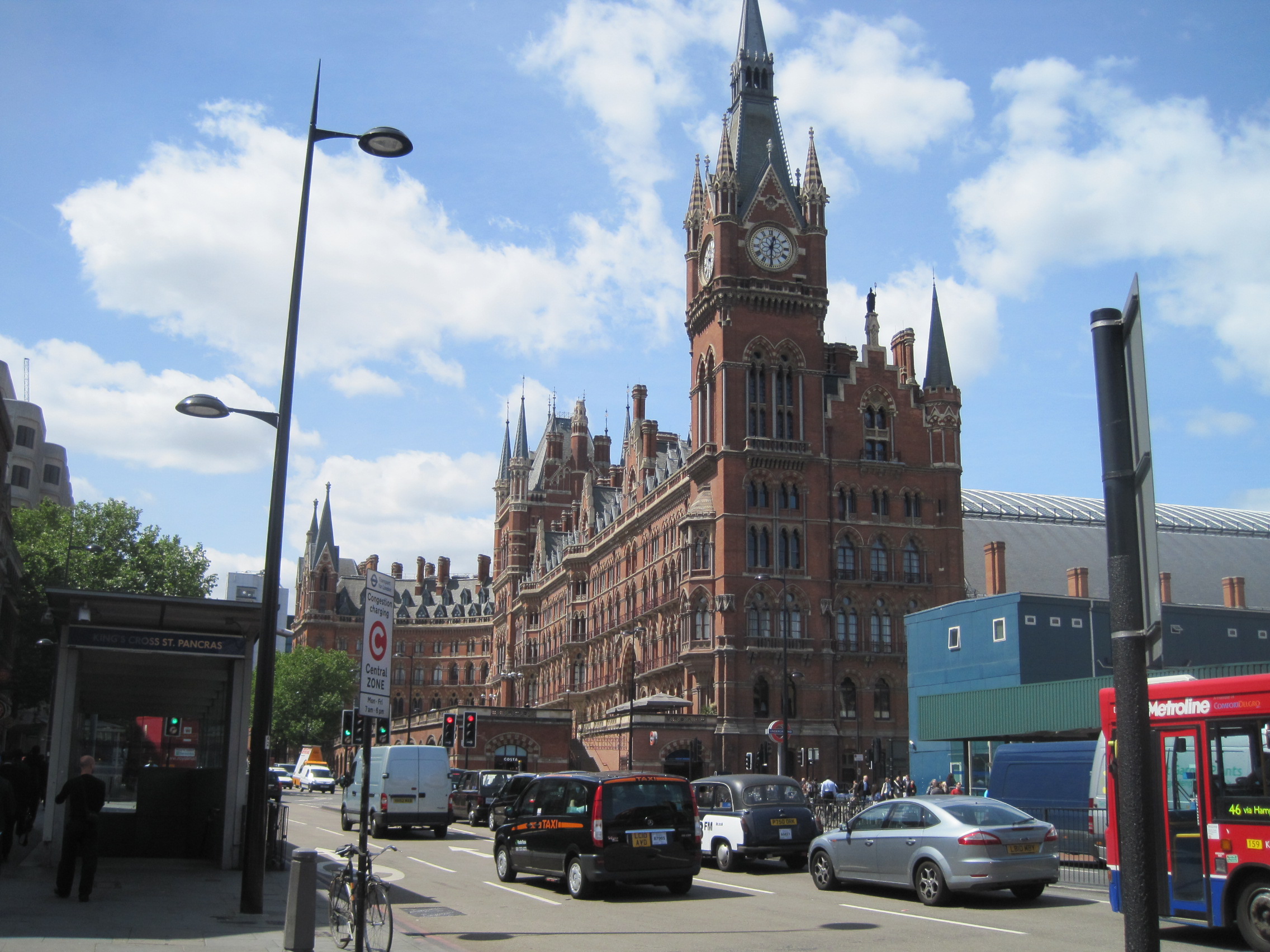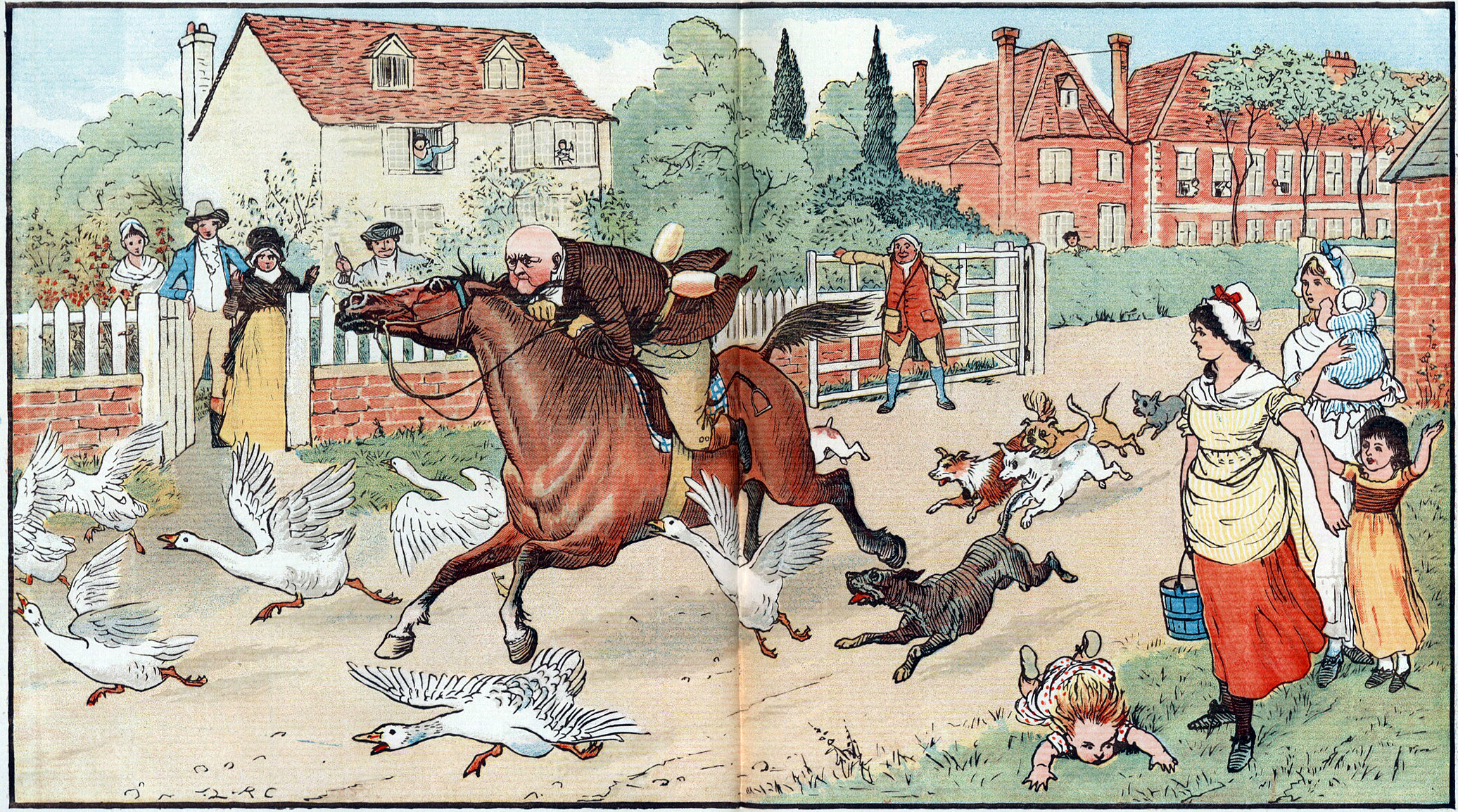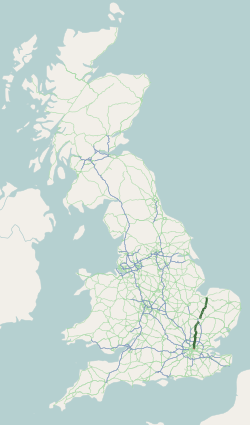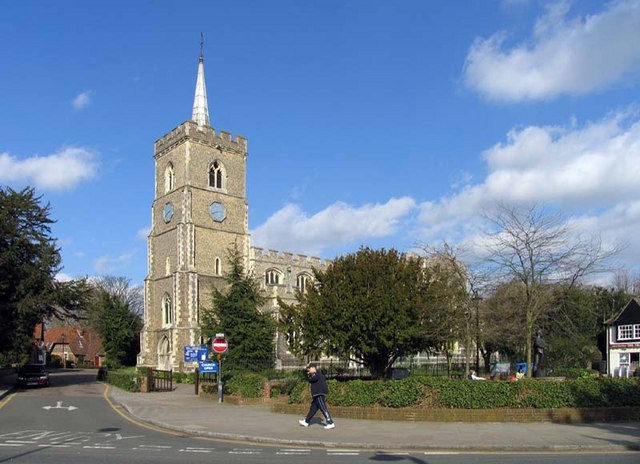|
A1010 Road (Great Britain)
The A1010 is a road running through north London from Bruce Grove in Tottenham to Waltham Cross. It also used to continue north through Cheshunt to Turnford. The road parallels the A10 Great Cambridge Road to its west. Route The southern end of the A1010 is named Tottenham High Road, becoming Fore Street from Upper Edmonton to Edmonton Green. For the northern part the name Hertford Road is used, passing through Ponders End, Enfield Highway, Enfield Wash, Freezywater and Bullsmoor. At Waltham Cross the old route is the pedestrianised High Street, which the designated A1010 by-passes, terminating at the A121. To the north the historic route to Ware is now designated as the B176 and A1170. History The road is part of the historic Hertford Road, a route running north from Bishopsgate along the western side of the Lea Valley, through Stoke Newington, Tottenham, Edmonton, Ponders End, Waltham Cross, Cheshunt and Broxbourne to Hoddesdon, where it split into Hertford and Wa ... [...More Info...] [...Related Items...] OR: [Wikipedia] [Google] [Baidu] |
North London
North London is the northern part of London, England, north of the River Thames. It extends from Clerkenwell and Finsbury, on the edge of the City of London financial district, to Greater London's boundary with Hertfordshire. The term ''north London'' is used to differentiate the area from south London, east London and west London. Some parts of north London are also part of Central London. There is a Northern postal area, but this includes some areas not normally described as part of north London, while excluding many others that are. Development The first northern suburb developed in the Soke of Cripplegate in the early twelfth century, but London's growth beyond its Roman northern gates was slower than in other directions, partly because of the marshy ground north of the wall and also because the roads through those gates were less well connected than elsewhere. The parishes that would become north London were almost entirely rural until the Victorian period. Many of t ... [...More Info...] [...Related Items...] OR: [Wikipedia] [Google] [Baidu] |
Stoke Newington
Stoke Newington is an area occupying the north-west part of the London Borough of Hackney in north-east London, England. It is northeast of Charing Cross. The Manor of Stoke Newington gave its name to Stoke Newington the ancient parish. The historic core on Stoke Newington Church Street retains the distinct London village character which led Nikolaus Pevsner to write in 1953 that he found it hard to see the district as being in London at all. Boundaries The modern London Borough of Hackney was formed in 1965 by the merger of three former Metropolitan Boroughs, Hackney and the smaller authorities of Stoke Newington and Shoreditch. These Metropolitan Boroughs had been in existence since 1899 but their names and boundaries were very closely based on parishes dating back to the Middle Ages. Unlike many London districts, such as nearby Stamford Hill and Dalston, Stoke Newington has longstanding fixed boundaries; however, to many. the informal perception of Stoke Newington h ... [...More Info...] [...Related Items...] OR: [Wikipedia] [Google] [Baidu] |
Transport In The London Borough Of Haringey
Transport (in British English), or transportation (in American English), is the intentional movement of humans, animals, and goods from one location to another. Modes of transport include air, land (rail and road), water, cable, pipeline, and space. The field can be divided into infrastructure, vehicles, and operations. Transport enables human trade, which is essential for the development of civilizations. Transport infrastructure consists of both fixed installations, including roads, railways, airways, waterways, canals, and pipelines, and terminals such as airports, railway stations, bus stations, warehouses, trucking terminals, refueling depots (including fueling docks and fuel stations), and seaports. Terminals may be used both for interchange of passengers and cargo and for maintenance. Means of transport are any of the different kinds of transport facilities used to carry people or cargo. They may include vehicles, riding animals, and pack animals. Vehicles may inclu ... [...More Info...] [...Related Items...] OR: [Wikipedia] [Google] [Baidu] |
Transport In The London Borough Of Enfield
Transport (in British English), or transportation (in American English), is the intentional movement of humans, animals, and goods from one location to another. Modes of transport include air, land (rail and road), water, cable, pipeline, and space. The field can be divided into infrastructure, vehicles, and operations. Transport enables human trade, which is essential for the development of civilizations. Transport infrastructure consists of both fixed installations, including roads, railways, airways, waterways, canals, and pipelines, and terminals such as airports, railway stations, bus stations, warehouses, trucking terminals, refueling depots (including fueling docks and fuel stations), and seaports. Terminals may be used both for interchange of passengers and cargo and for maintenance. Means of transport are any of the different kinds of transport facilities used to carry people or cargo. They may include vehicles, riding animals, and pack animals. Vehicles may inclu ... [...More Info...] [...Related Items...] OR: [Wikipedia] [Google] [Baidu] |
Learners
''Learners'' is a British comedy drama television film starring David Tennant and Jessica Hynes. The film was announced by the BBC on 3 April 2007 and was broadcast on 11 November 2007. The DVD was released on 12 November 2007. Synopsis The film tells the story of a group of learner drivers. One of them, Beverly (Jessica Hynes), is a housewife who works as a cleaner at the police station and has failed her driving exams eight times, mainly because her husband Ian (Shaun Dingwall) is too impatient giving her driving lessons. She decides to take driving lessons from Chris (David Tennant), a devout Christian driving instructor at Gear Change, with whom she falls in love. However Chris loves his boss Fiona ( Sarah Hadland) who is having an affair with Beverly's colleague, policeman Gerry. Beverly tries to raise cash for her driving lessons, because Ian spent all their money on a pair of owls, hoping to sell their offspring for a profit. She ends up looting her daughter's savings for ... [...More Info...] [...Related Items...] OR: [Wikipedia] [Google] [Baidu] |
Enfield Highway
Enfield Highway is an area in the London Borough of Enfield, north London. It is roughly located in the area either side of Hertford Road (Enfield Highway) between Hoe Lane and The Ride. Etymology Enfield Highway is marked thus on the Ordnance Survey map of 1822, it is a settlement mainly from the eighteenth century named from the '' kings highe way leading to London'' 1610, the highway being the Roman road Ermine Street (now the A1010 Hertford Road). The name of the hamlet along this stretch of road was recorded as "Cocksmiths End" in 1572 and in 1658. Education * Enfield College * St Ignatius' College * Bishop Stopford's School Thomas Ford in his history of Enfield (1873) records the existence in Enfield Highway of "a school for 160 boys, with a master's house, built in 1872, near the Church, under a certificated master and three pupil teachers" and a "girls' and infants' school at the Highway,for 260 children, taught by a certificated mistress, and four pupil teacher ... [...More Info...] [...Related Items...] OR: [Wikipedia] [Google] [Baidu] |
Public House
A pub (short for public house) is a kind of drinking establishment which is licensed to serve alcoholic drinks for consumption on the premises. The term ''public house'' first appeared in the United Kingdom in late 17th century, and was used to differentiate private houses from those which were, quite literally, open to the public as "alehouses", "taverns" and "inns". By Georgian times, the term had become common parlance, although taverns, as a distinct establishment, had largely ceased to exist by the beginning of the 19th century. Today, there is no strict definition, but CAMRA states a pub has four characteristics:GLA Economics, Closing time: London's public houses, 2017 # is open to the public without membership or residency # serves draught beer or cider without requiring food be consumed # has at least one indoor area not laid out for meals # allows drinks to be bought at a bar (i.e., not only table service) The history of pubs can be traced to Roman taverns in B ... [...More Info...] [...Related Items...] OR: [Wikipedia] [Google] [Baidu] |
The Diverting History Of John Gilpin
''The Diverting History of John Gilpin Shewing how he went Farther than he intended, and came safe Home again'' is a comic ballad by William Cowper written in 1782 in poetry, 1782. The ballad concerns a draper called John Gilpin who rides a Bolting (horse), runaway horse. Cowper heard the story from Lady Anna Austen at a time of severe depression, and it cheered him up so much that he put it into verse. The poem was published anonymously in the ''Public Advertiser'' in 1782, and then published with ''The Task (poem), The Task'' in 1785 in poetry, 1785.Cox, Michael, editor, ''The Concise Oxford Chronology of English Literature'', Oxford University Press, 2004, It was very popular, to the extent that "Copyright infringement, pirate copies were being sold all across the country, together with Gilpin Merchandising, books and toys." The poem was republished in 1878, illustrated by Randolph Caldecott and printed by Edmund Evans. Caldecott's image of Gilpin riding the horse is the bas ... [...More Info...] [...Related Items...] OR: [Wikipedia] [Google] [Baidu] |
William Cowper
William Cowper ( ; 26 November 1731 – 25 April 1800) was an English poet and Anglican hymnwriter. One of the most popular poets of his time, Cowper changed the direction of 18th-century nature poetry by writing of everyday life and scenes of the English countryside. In many ways, he was one of the forerunners of Romantic poetry. Samuel Taylor Coleridge called him "the best modern poet", whilst William Wordsworth particularly admired his poem ''Yardley-Oak''. After being institutionalised for insanity, Cowper found refuge in a fervent evangelical Christianity. He continued to suffer doubt and, after a dream in 1773, believed that he was doomed to eternal damnation. He recovered and wrote more religious hymns. His religious sentiment and association with John Newton (who wrote the hymn "Amazing Grace") led to much of the poetry for which he is best remembered, and to the series of Olney Hymns. His poem "Light Shining out of Darkness" gave English the phrase: "God moves ... [...More Info...] [...Related Items...] OR: [Wikipedia] [Google] [Baidu] |
Great Cambridge Road
The A10 (in certain sections known as ''Great Cambridge Road'' or Old North Road) is a major road in England. Its southern end is at London Bridge in the London Borough of Southwark, and its northern end is the Norfolk port town of King's Lynn. From London to Royston it chiefly follows the line of Roman Ermine Street. The main route to Cambridge is now via the M11 motorway, however non-motorway traffic still uses the A10. Route Within the City of London, the route of the A10 comprises King William Street, Gracechurch Street, Bishopsgate and Norton Folgate. It then becomes Shoreditch High Street, Kingsland Road, Kingsland High Street and Stoke Newington Road. It runs through Stoke Newington as Stoke Newington High Street and then becomes Stamford Hill, through Stamford Hill until Tottenham. In July 2013, the Tottenham Hale gyratory was removed and the A10 now follows the route of Tottenham High Road in both directions. North of Tottenham, the A10 leaves its historical ... [...More Info...] [...Related Items...] OR: [Wikipedia] [Google] [Baidu] |
Ermine Street
Ermine Street is a major Roman road in England that ran from London (''Londinium'') to Lincoln (''Lindum Colonia'') and York (''Eboracum''). The Old English name was ''Earninga Strǣt'' (1012), named after a tribe called the ''Earningas'', who inhabited a district later known as ''Armingford Hundred'', around Arrington, Cambridgeshire, and Royston, Hertfordshire. "Armingford", and "Arrington" share the same Old English origin. The original Celtic and Roman names for the route remain unknown. It is also known as the Old North Road from London to where it joins the A1 Great North Road near Godmanchester. Course Ermine Street begins at Bishopsgate, where one of the seven gates in the wall surrounding Roman London was located. From here it runs north up Norton Folgate, Shoreditch High Street and Kingsland Road through Stoke Newington (forming Stoke Newington Road and Stoke Newington High Street), Tottenham, Edmonton and eastern Enfield (Ponders End, Enfield Highway, Enfield W ... [...More Info...] [...Related Items...] OR: [Wikipedia] [Google] [Baidu] |
Ware, Hertfordshire
Ware is a town in Hertfordshire, England close to the county town of Hertford. It is also a civil parishes in England, civil parish in East Hertfordshire district. Location The town lies on the north–south A10 road (Great Britain), A10 road which is partly shared with the east–west A414 road, A414 (for Hertford to the west and Harlow to the east). There is a large Kingsmead Viaduct, viaduct over the River Lee (England), River Lea at Kings Meads. The £3.6m two-mile bypass opened on 17 January 1979. At the north end of the bypass is the Wodson Park Sports and Leisure Centre and Hanbury Manor, a hotel and country club. The former route of the A10 through the town is now the A1170. The Ware railway station, railway station is on the Hertford East Branch Line and operated by Greater Anglia (train operating company), Greater Anglia and is on a short single track section of the otherwise double track line. History Archaeology has shown that Ware has been occupied since at least t ... [...More Info...] [...Related Items...] OR: [Wikipedia] [Google] [Baidu] |








